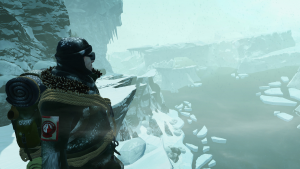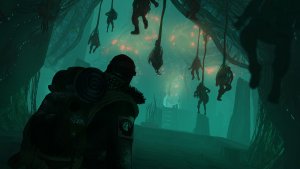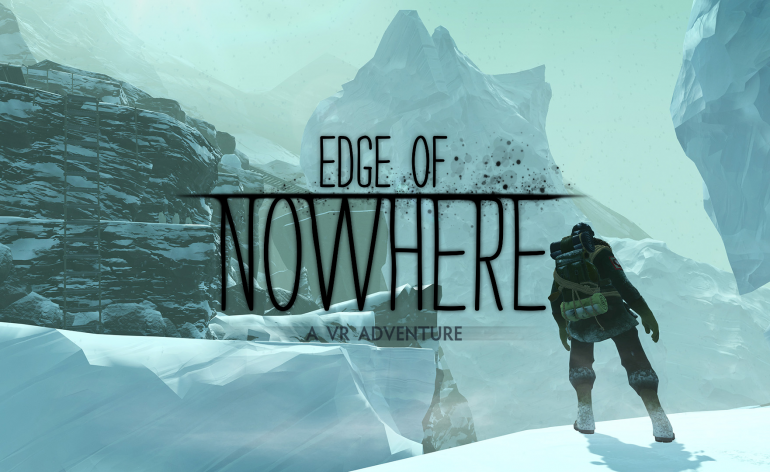Edge of Nowhere review – Cliffs of Craziness
Nothing says virtual reality like madness and tentacles. Edge of Nowhere delivers both of those in spades to the Oculus Rift. I’ve enjoyed playing many games on the Rift, but plenty of those titles still felt like the first forays into VR gaming. Because VR at home is so new, I give them some amount of slack for being pioneers of the genre. This, however, feels like a serious AAA console game being brought into the world of 3D immersion. Granted, Edge of Nowhere only requires about 6 hours of gameplay from start to finish on the default difficulty setting (presuming a reasonable amount of success). It’s an amazing game in its own right and a promise of the quality of gaming that is to come.
Edge of Nowhere is a tale of horror and madness from Insomniac Games that acts as a video game homage to the works of H.P. Lovecraft. Following a brief introduction, we find the game set in Antarctica sometime in the 1920s. Our hero, Victor Howard, is headed to the frozen wasteland in search of his fiance. She and her expedition have gone missing, their fates soon to be discovered. The dead are everywhere and their final notes paint a disturbing portrait of bizarre behavior and murder. And that’s about when the abhorrent monsters start to appear. I feel like this is the closest we’ll ever likely get to a Mountains of Madness video game.
The camera is disorienting at first.
The biggest challenge of a third person adventure game in VR as a player is getting accustomed to the camera. Edge of Nowhere isn’t entirely on rails, nor is it simply running down a hallway. At the same time, paths are very clear and movement works independently of the direction that the player is looking. For other Oculus Rift owners, it’s similar to the chase camera for Lucky’s Tale. Following behind a character that moves onward while dragging a camera along as it goes can be quite disorienting at first. I personally found that i grew accustomed to it quickly, but I’d presume it’ll be different for everyone. If motion sickness is an issue, I’d suggest taking it easy with the running while looking around. Losing your lunch while gaming is probably a bad idea.
Makes me wish the Rift had a MUCH larger field of vision.
 Despite being confined primarily to an endless field of snow or dark caves, Edge of Nowhere exists in a fairly compelling environment. It’s enough to make me wish that I could get far more in the way of peripheral vision with my game play. Of course, one bonus of having a bit of tunnel vision is that you can’t look down unless you really intend to. If heights freak you out, I wouldn’t suggest looking down while clinging to the side of a cliff face unless you want to risk falling out of your chair. There’s still plenty to look at other than the 100 foot drop looming below. I personally found that the detail present in things as simple as the ice was worth noting when not being stalked by some sort of eldritch horror.
Despite being confined primarily to an endless field of snow or dark caves, Edge of Nowhere exists in a fairly compelling environment. It’s enough to make me wish that I could get far more in the way of peripheral vision with my game play. Of course, one bonus of having a bit of tunnel vision is that you can’t look down unless you really intend to. If heights freak you out, I wouldn’t suggest looking down while clinging to the side of a cliff face unless you want to risk falling out of your chair. There’s still plenty to look at other than the 100 foot drop looming below. I personally found that the detail present in things as simple as the ice was worth noting when not being stalked by some sort of eldritch horror.
Stick to the shadows.
Edge of Nowhere is primarily a stealth game if played on medium or higher difficulty. I found enough shotgun ammo to keep myself from getting overwhelmed if I screwed up sneaking, but not much more. I’m not bad at stealth, mind you. Most of the things in the caverns are sound sensitive, so throwing rocks to distract them for a minute is the preferred way of getting around. The monsters aren’t smart, but trying to navigate around them in a dark cave in VR can still feel rather tense. I jumped nearly every time I failed a stealth attempt and was forced to fight. I also found that there were times where being sneaky wasn’t an option as well as times when failing meant immediate death.
Atmospheric and unnerving.
 I think we can all agree that immersive environments are key to a good VR game. The atmosphere in Edge of Nowhere does a good job of keeping the player guessing. I began noticing the superb use of virtual madness when I walked into a cavern and thought I saw a table and chair. However, when I looked again, it was gone. These sorts of things happen a lot in the game and I quickly realized that I may not be able to trust anything I saw. Certainly, the halls of Miskatonic probably weren’t really in a cave in Antarctica. But did that letter I just read really say what I thought it did? Is Victor going so mad that I can’t even trust in these notes? Without spoiling things too much, I’ll just say that the game has a tendency to pull the rug out from under the player when they least expect it.
I think we can all agree that immersive environments are key to a good VR game. The atmosphere in Edge of Nowhere does a good job of keeping the player guessing. I began noticing the superb use of virtual madness when I walked into a cavern and thought I saw a table and chair. However, when I looked again, it was gone. These sorts of things happen a lot in the game and I quickly realized that I may not be able to trust anything I saw. Certainly, the halls of Miskatonic probably weren’t really in a cave in Antarctica. But did that letter I just read really say what I thought it did? Is Victor going so mad that I can’t even trust in these notes? Without spoiling things too much, I’ll just say that the game has a tendency to pull the rug out from under the player when they least expect it.
Sometimes the atmosphere is less about questioning sanity and more about the crazy things going down in service of an Old One. Those guys hanging from the ceiling probably aren’t going to make it. I don’t know about you, but giant tentacles writhing under the ice seems like a bad thing to me. I’m not sure how I didn’t spot the creature the size of a city block on my flight in, but it’s sure as heck got my attention now. What I’m saying is that sometimes the horror isn’t subtle or simply psychological.
All good things.
The unfortunate thing about Edge of Nowhere is that it’s over so quickly. I felt so much like I was in a mashup of Tomb Raider and the Lovecraft mythos that I wanted it to go on for a week. I can’t imagine that a high quality VR adventure game is cheap or easy to make, but I’ve been spoiled by recent entries in the genre. (At least in the mundane 2D version of the genre.) The controls can sometimes feel clumsy, but that’s the exception, not the rule. Part of that is likely just my difficulty adapting to an actual 3D environment. Otherwise, it’s a fantastic game with a narrative close to my heart. There’s very little that felt like filler for the sake of making the experience last longer. If there’s any game currently on the Oculus Store that I’d list as must-play, it’s this one.
Edge of Nowhere is available exclusively on Oculus Rift.






